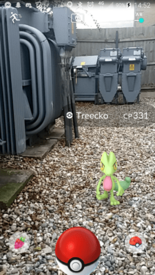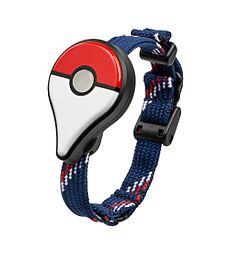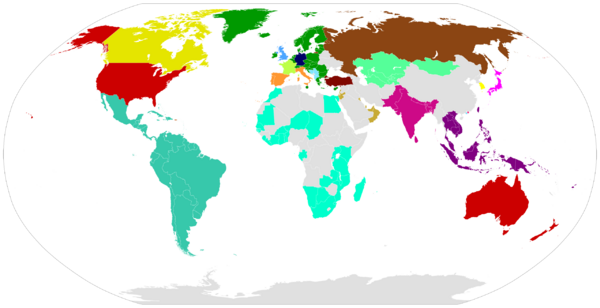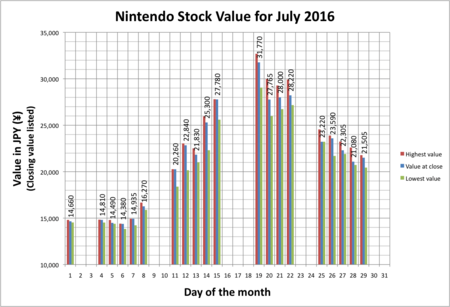Pokémon Go facts for kids
Quick facts for kids Pokémon Go |
|
|---|---|
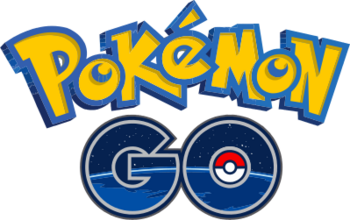
Game logo
|
|
| Developer(s) | Niantic |
| Publisher(s) | Niantic |
| Director(s) | Tatsuo Nomura |
| Producer(s) | Steve Wang |
| Designer(s) | Matthew Ein Junichi Masuda |
| Programmer(s) | Game Freak |
| Artist(s) | Dennis Hwang Yusuke Kozaki Mieke Hutchins |
| Composer(s) | Junichi Masuda |
| Series | Pokémon |
| Engine | Unity |
| Platform(s) | iOS, Android |
| Release date(s) |
July 6, 2016
|
| Genre(s) | Augmented reality, location-based game |
Pokémon Go is a super popular mobile game that came out in 2016. It uses something called augmented reality (AR). This means it mixes the real world with virtual things. You play it on your phone or tablet.
The game was made by Niantic with Nintendo and The Pokémon Company. It lets you find, catch, train, and battle virtual Pokémon. These Pokémon appear as if they are right in your real-world location! The game uses your phone's GPS to know where you are.
Pokémon Go is free to play. You can buy extra items in the game if you want. When it first launched, it had about 150 different Pokémon. Now, there are hundreds more to discover!
The game got a lot of attention. People loved the idea of finding Pokémon in the real world. It became one of the most used and profitable apps in 2016. It helped make AR technology and location-based games famous. It also encouraged people to be more active and helped local businesses. However, there were some concerns about safety and public issues. By early 2019, it had been downloaded over a billion times!
Contents
How to Play Pokémon Go
Exploring with Augmented Reality
When you start Pokémon Go, you create your own avatar. This is your character in the game. Your avatar then shows up on a map that looks like your real-world location.
On the map, you'll see 'PokéStops' and 'Pokémon Gyms'. PokéStops are places where you can get useful items like Poké Balls. You can also use 'Lure Modules' at PokéStops to attract more Pokémon. Gyms are where you can battle other players' Pokémon. These spots are usually at interesting places like parks or landmarks.
As you walk around in the real world, your avatar moves on the game map. Different Pokémon types appear in different areas. For example, Water-type Pokémon are often found near water. When you find a Pokémon, you can see it in AR mode. This uses your phone's camera to make it look like the Pokémon is really there! You can even take pictures of them.
Getting Items and Powering Up
Even though the game is free, you can buy extra items. These include more Poké Balls to catch Pokémon. You can also buy 'Incense' to attract Pokémon to you. 'Lure Modules' attract Pokémon to a PokéStop for everyone nearby. 'Lucky Eggs' help you earn double experience points for a short time.
Every Pokémon has a 'Combat Power' (CP). This shows how strong it is. As you level up in the game, you'll find Pokémon with higher CP. You can also make your Pokémon stronger using 'Candies' and 'Stardust'. These are currencies you earn in the game.
Making Your Avatar Unique
You can change how your avatar looks. There are different clothes like hats, shirts, and shoes. Some clothes match specific Pokémon or teams. Many clothing items are free, but some can be bought with in-game coins. You earn coins by leveling up or completing special tasks.
You can also change your avatar's pose. Some poses are free, while others can be bought or earned during special events. In April 2024, the game added more ways to customize avatars. You can now change hair styles, body size, and skin color.
Catching and Collecting Pokémon
In Pokémon Go, you don't battle wild Pokémon to catch them. Instead, you throw a Poké Ball at them by flicking it on your screen. If you throw it well, the Pokémon will be caught! The success of catching depends on things like the Pokémon's type and the kind of Poké Ball you use.
When you catch a Pokémon, you get 'Candies' and 'Stardust'. You use these to make your Pokémon stronger or to evolve them into new forms. Each Pokémon family has its own type of Candy. You can also send Pokémon to Professor Willow to get more Candies.
A fun goal in the game is to complete your Pokédex. This is like a digital encyclopedia of all the Pokémon you've caught and evolved.
In September 2016, a "Buddy Pokémon" feature was added. You can choose one Pokémon to be your buddy. It walks with you on your profile screen and helps you earn rewards. The more you walk in real life, the more Candies your buddy can find!
Since January 2018, Pokémon Go has monthly "Community Day" events. During these days, a special Pokémon appears more often. If you evolve it during the event, it learns an exclusive move. You also have a better chance to find a 'Shiny' version of that Pokémon.
New Pokémon Appearances
The game is always getting new Pokémon. As of February 2025, there are 884 Pokémon in the game. This includes different regional versions.
Special 'Mythical' and 'Legendary' Pokémon often appear in unique events or quests. For example, Groudon was the first Legendary Pokémon released in December 2017.
In August 2020, 'Mega Evolution' came to Pokémon Go. This lets certain Pokémon temporarily transform into a super powerful form during battles.
Pokémon Battles and Raids
As you play and earn experience points (XP), you level up. At level five, you can join one of three teams: Team Instinct (yellow), Team Mystic (blue), or Team Valor (red). These teams battle for control of Gyms.
Gyms and Raids Explained
In June 2017, Gyms were updated to be more about teamwork. Now, you can spin a part of the Gym to get items. Only six Pokémon can defend a Gym at a time, and they all must be different. You earn coins based on how long your Pokémon stays in a Gym.
'Raid Battles' were added in July 2017. These are big battles where a group of players team up to fight a very strong Pokémon at a Gym. If you win, you get a chance to catch that Pokémon. Raids have different difficulty levels. Level 5 raids are usually for Legendary Pokémon.
In May 2022, 'Mega Legendary Pokémon' were added to raids. These are even tougher battles! In October 2022, "Elite Raids" were introduced. These are very hard raids that you can only do in person. In May 2023, "Shadow Raids" arrived. You can catch a "Shadow Pokémon" if you win. These Pokémon are stronger in attack but weaker in defense. You can also "purify" them to make them normal.
Fighting Other Players
In December 2018, Pokémon Go added 'Trainer Battles'. This lets you battle other players. In January 2020, the 'Go Battle League' was launched. This lets you battle players from all over the world online!
In these battles, you use a team of three Pokémon. You tap your screen to use "fast moves" and then "charged moves." You can also use "protect shields" to block attacks or switch your Pokémon. There are three main leagues:
- Great League: Pokémon must have 1,500 CP or less.
- Ultra League: Pokémon must have 2,500 CP or less.
- Master League: No CP limit.
The Go Battle League is even used in competitive Pokémon tournaments, like the Pokémon World Championships.
Team Go Rocket Battles
In July 2019, 'Team GO Rocket' battles were added. You can find Team GO Rocket characters at some PokéStops or in balloons that appear on your map. If you win, you get a chance to catch a "Shadow Pokémon." These Pokémon have a bonus to their attack but a penalty to their defense. You can choose to purify them later.
Dynamax and Gigantamax Battles
In September 2024, 'Dynamax Battles' were introduced. These battles let up to four players team up against a giant 'Dynamax Pokémon'. You use special "MP" currency to join. You can also 'Dynamax' your own Pokémon during the battle to make them stronger.
'Gigantamax Battles' started in October 2024. They are similar to Dynamax battles, but up to 40 players can join one battle! Only specific Pokémon can become Gigantamax.
How Pokémon Go Was Made
The idea for Pokémon Go came from a fun April Fools' Day joke in 2014. It was a collaboration between Satoru Iwata of Nintendo and Tsunekazu Ishihara of The Pokémon Company with Google. Ishihara liked Niantic's previous AR game, Ingress. He thought its idea would be perfect for Pokémon.
Niantic used information from Ingress to decide where to put PokéStops and Gyms. They also used Google Maps data to help Pokémon appear in certain places. The game's music was written by Junichi Masuda, who has composed music for many Pokémon games. Dennis Hwang, who designed the Gmail logo, also worked on the game's graphics.
Before the game was fully released, Niantic did a beta test in Japan in March 2016. This allowed players to help find bugs and improve the game. The test later expanded to Australia, New Zealand, and the United States. It ended on June 30, 2016.
After the Game Launched
At the 2016 San Diego Comic-Con, John Hanke, the founder of Niantic, showed off the three team leaders: Candela (Team Valor), Blanche (Team Mystic), and Spark (Team Instinct). He said that only about 10% of their ideas for the game were in it at launch. He also promised that Niantic would keep supporting the game for many years.
In December 2016, Starbucks and Sprint worked with Nintendo to turn some of their locations into PokéStops and Gyms. An app for Apple Watch was also released, letting users get notifications about nearby Pokémon.
In February 2017, a big update added 100 new Pokémon from the Johto region. More Pokémon from the Hoenn region were added later in 2017. A weather system was also added, so real-world weather could affect the game.
In November 2018, a new Nintendo Switch game called Pokémon: Let's Go, Pikachu! and Let's Go, Eevee! was released. It was inspired by Pokémon Go and allowed you to transfer Pokémon between the two games. A new Pokémon called Meltan was first revealed in Pokémon Go.
In 2020, Niantic made big changes to the game because of the COVID-19 pandemic. They added things like indoor step tracking and long-distance player-versus-player battles. This helped players enjoy the game even when they couldn't leave their homes much.
Pokémon Go Plus Device
The Pokémon Go Plus is a small Bluetooth device you can wear. It lets you play parts of the game without looking at your phone. When you are near a Pokémon or PokéStop, the Plus vibrates. You can then press a button to try and catch the Pokémon or get items from the PokéStop.
The Pokémon Go Plus was released in the UK and North America on September 16, 2016. On July 14, 2023, the Pokémon Go Plus + was released. This newer version can automatically catch Pokémon and interact with PokéStops. It also has sleep tracking features for use with Pokémon Sleep.
Game Release
Where Pokémon Go Was Released
Pokémon Go first launched on July 6, 2016, in Australia, New Zealand, and the United States. Because so many people wanted to play, the game's servers had trouble keeping up. Niantic had to pause releases in other countries to fix these issues.
European countries started getting the game on July 13, and most of the continent had it within ten days. Japan's release was delayed a bit but came out on July 22. France's launch was also postponed due to safety concerns. After fixing server issues, Niantic continued releasing the game worldwide. Central and South America, and most of Southeast Asia, got the game in early August.
In South Korea, the game wasn't officially released at first due to map restrictions. However, a small area around Sokcho became playable due to a glitch. Many people traveled there just to play! The game officially launched in South Korea in January 2017.
In mainland China, Google services are blocked, which affected the game. Players there had to use special methods to play. Some even used a clone app called City Spirit Go.
When the game launched in Taiwan in August 2016, it became super popular. Thousands of people played in cities like Taipei. One player, Chen Ching-Po, became famous as "Uncle Pokémon" for riding his bicycle with 72 phones to play multiple accounts!
The game was released in the Balkans, Macau, and Central Asia in September 2016. By the end of that year, it was also available across Africa, the Middle East, and South Asia. On September 11, 2018, the game appeared in Russia. In May 2019, it became available on the Samsung Galaxy Store.
How the Game Affected Companies
Nintendo's Experience
When Pokémon Go first came out, investors were very excited. Nintendo's share price went up a lot, even though Nintendo only owns a part of The Pokémon Company and Niantic. Within five days, Nintendo's market value increased by US$9 billion!
By July 19, Nintendo's stock value had more than doubled. People thought that if Pokémon Go was so successful, future Nintendo mobile games would be too. However, on July 25, Nintendo clarified that they didn't make Pokémon Go and wouldn't get huge financial gains from it. After this, their stock price dropped by 18%.
Other Companies' Experiences
Other companies also saw their stock prices go up because of Pokémon Go. Companies like Tomy and TV Tokyo had significant gains. Zagg, a company that makes battery cases for phones, saw its stock rise by 25% because so many players needed to charge their phones!
Technical Problems
When Pokémon Go first launched, the game's servers often crashed. This was because so many people were trying to play at once. The game had 50 times more traffic than expected! Players had trouble logging in and staying connected for days.
On July 16, 2016, the servers went down again after the game launched in many European countries. A hacking group claimed they caused the outage, but the problem was fixed later that day. The next day, the servers crashed again when the game launched in Canada. John Hanke, Niantic's founder, apologized for the server issues.
Some early versions of the game on Apple phones asked for full access to players' Google accounts. This caused privacy concerns. Niantic quickly fixed this, saying it was a mistake. They also promised that no extra information was collected.
Game Glitches
Besides server problems, Pokémon Go also had some glitches. One big bug in mid-July 2016 made the Pokémon tracking feature useless. It was called the "three-step-glitch" because it always showed three footsteps, no matter how close you were to a Pokémon. Niantic later removed this feature.
Another bug in August caused captured Pokémon to swap with other creatures randomly. Some very rare 'Legendary Pokémon' were also accidentally given to players due to a glitch. These were later removed to keep the game fair.
Awards and Recognition
| Award | Category | Result | Ref |
|---|---|---|---|
| BBC Radio 1's Teen Awards 2016 | Best Game | Won | |
| The Game Awards 2016 | Best Mobile/Handheld Game | Won | |
| Best Family Game | Won | ||
| Golden Joystick Awards 2016 | Innovation of the Year | Won | |
| Handheld/Mobile Game of the Year | Won | ||
| 2016 TechRaptor Awards | Best Mobile/Handheld Game | Won | |
| 20th Annual D.I.C.E. Awards | Game of the Year | Nominated | |
| Mobile Game of the Year | Won | ||
| New York Game Critic Awards | A-Train Award for Best Mobile Game | Won | |
| Central Park Zoo Award for Best Kids Game | Won | ||
| Game Developers Choice Awards 2016 | Best Mobile/Handheld Game | Won | |
| Innovation Award | Nominated | ||
| Best VR/AR Game | Nominated | ||
| British Academy Children's Awards 2017 | Game | Won | |
| International Mobile Gaming Awards 2017 | Grand Prix | Won | |
| 2017 SXSW Gaming Awards | Mobile Game of the Year | Won | |
| Excellence in Technical Achievements | Nominated | ||
| 13th British Academy Games Awards | Family | Nominated | |
| Game Innovation | Nominated | ||
| Mobile | Won | ||
| Golden Joystick Awards 2018 | Still Playing Award | Nominated | |
| Gamers' Choice Awards 2018 | Fan Favorite Mobile Game | Won | |
| 2019 SXSW Gaming Awards | Most Evolved Game | Nominated | |
| 15th British Academy Games Awards | EE Mobile Game of the Year | Nominated | |
| Pocket Gamer Mobile Games Awards | Best Live Ops | Nominated | |
| 16th British Academy Games Awards | EE Mobile Game of the Year | Nominated | |
| 2021 Kids' Choice Awards | Favorite Video Game | Nominated |
See also
 In Spanish: Pokémon GO para niños
In Spanish: Pokémon GO para niños
- List of Pokémon, the list of all of the original Pokémon by order
- Pikmin Bloom, Similar game also developed by Niantic and Nintendo



